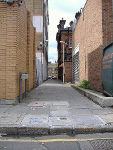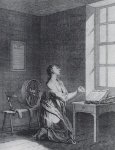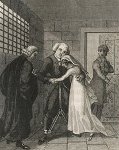

 The first English,
non-Catholic, version was established in (Great) Prescot Street in 1758, with a
7-year lease on the commodious house vacated by the London Hospital,
which provided space, aire and privacy at a modest expence. Today,
the narrow Magdalen Passage [sign left]
runs through its former site. Six penitents were
admitted on the first day; by 1769, 1,500 had passed through its doors,
most having stayed for three years - it was judged a success, and had
little difficulty in raising funds. Typical collections from chapel
visitors were well over £1,000, whereas even the Foundling Hospital
could only raise £160.
The first English,
non-Catholic, version was established in (Great) Prescot Street in 1758, with a
7-year lease on the commodious house vacated by the London Hospital,
which provided space, aire and privacy at a modest expence. Today,
the narrow Magdalen Passage [sign left]
runs through its former site. Six penitents were
admitted on the first day; by 1769, 1,500 had passed through its doors,
most having stayed for three years - it was judged a success, and had
little difficulty in raising funds. Typical collections from chapel
visitors were well over £1,000, whereas even the Foundling Hospital
could only raise £160.| Humanity in its utmost efforts pleads their cause more powerfully than anything I can offer on the subject; and I appeal to every mind, from its own experience, if there can be greater Objects of Compassion, than poor, young, thoughtless Females, plunged into ruin by those temptations to which their very youth and personal advantages exposes them, no less than those passions implanted by nature.... and by those endowed with superior faculties, and all the advantages of Education and fotune, what virtue can be proof against such formidable Seducers, who offer too commonly, and too profusely promise to transport the thoughtless Girls from Want, Confinement and Restraint of Passions, to Luxury, Liberty, Gaiety, Joy. |
| This
new convent is beyond Goodman's Fields, and I assure you would content
any Catholic alive. The chapel is small and low, but neat, hung with
Gothic paper and tablets of benefactions. At the west end were inclosed
the sisterhood, above an hundred and thirty, all in greyish brown
stuffs, broad handkerchiefs, and flat straw hats with a ribband pulled
quite over their faces. As soon as we entered the chapel, the organ
played, and the Magdalens sang a hymn in parts; you cannot imagine how
well. The chapel was dressed with orange and myrtle, and there wanted
nothing but a little incense, to drive away the devil - or to invite
him. Prayers then began, psalms, and a sermon; the latter by a young
clergyman, one Dodd; who contributed to the Popish idea one had imbibed
by haranging entirely in the French style, and very eloquently and
touchingly. He apostrophised the lost sheep, who sobbed and cried from
their souls - so did my Lady Hertford and Fanny Pelham, till I believe
the City dames took them both for Jane Shores*. * Elizabeth 'Jane' Shore was one of the chief mistreses of Edward IV in the latter part of the 15th century - there was a Jane Shore Alley in Shoreditch. Is this also an early example of rhyming slang? |
 Although
deliberately called a 'hospital' because of the conviction that its
regime was therapeutic, there were also overtones
of the nunnery, in the way every detail was organised: anonymous and
drab clothing, strict rules about demeanour, conversation and
surveillance (tell your story to no one), diet, daily work and
worship. Wooden blinds covered the windows to stop prying eyes. Much of
this anticipated 19th century prison design and routine. Pictured is
the frontispiece from Jonas Hanway's Thoughts on the Plan for a Magdalen House (1758)
showing his ideals: note the rules on the wall, the spinning wheel, the
open bible....
Although
deliberately called a 'hospital' because of the conviction that its
regime was therapeutic, there were also overtones
of the nunnery, in the way every detail was organised: anonymous and
drab clothing, strict rules about demeanour, conversation and
surveillance (tell your story to no one), diet, daily work and
worship. Wooden blinds covered the windows to stop prying eyes. Much of
this anticipated 19th century prison design and routine. Pictured is
the frontispiece from Jonas Hanway's Thoughts on the Plan for a Magdalen House (1758)
showing his ideals: note the rules on the wall, the spinning wheel, the
open bible.... The Revd William Dodd
(born 1729, graduating from Clare College Cambridge in 1750) preached
the inaugural sermon at the opening of the Magdalen Hospital,
and was retained as its chaplain at £100 a year - money he needed, for
he had developed a lavish lifestyle: in his own rather ridiculous
words, he was a zealous
votary of the god of Dancing. He
was a popular and emotional society preacher, both at the Magdalen and
elsewhere. However, he does appear to have had a genuine and lasting
concern for the welfare of the residents, and certainly enabled the
institution to raise funds.
The Revd William Dodd
(born 1729, graduating from Clare College Cambridge in 1750) preached
the inaugural sermon at the opening of the Magdalen Hospital,
and was retained as its chaplain at £100 a year - money he needed, for
he had developed a lavish lifestyle: in his own rather ridiculous
words, he was a zealous
votary of the god of Dancing. He
was a popular and emotional society preacher, both at the Magdalen and
elsewhere. However, he does appear to have had a genuine and lasting
concern for the welfare of the residents, and certainly enabled the
institution to raise funds.
 His
debts became so great that, foolishly, he forged a bond. This was a
capital offence, and he was tried and sentenced to hang in 1777. Samuel
Johnson was among the many who pleaded for clemency - and it was in
relation to Dodd that he made his famous remark Depend
upon it Sir, when a man knows he is to be hanged
in a fortnight, it concentrates his mind wonderfully. But to no avail.
His
debts became so great that, foolishly, he forged a bond. This was a
capital offence, and he was tried and sentenced to hang in 1777. Samuel
Johnson was among the many who pleaded for clemency - and it was in
relation to Dodd that he made his famous remark Depend
upon it Sir, when a man knows he is to be hanged
in a fortnight, it concentrates his mind wonderfully. But to no avail.Homepage | About Us | Services & Events
| Church &
Churchyard |
History
Newsletters & Sermons | Contacts,
Links & Registers | Giving | Picture
Gallery |
Site Map